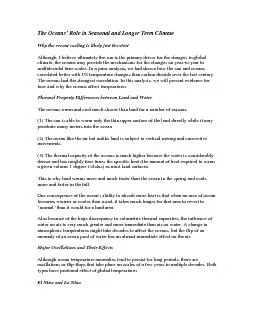/


The term El Ni ID: 214004
Download Pdf The PPT/PDF document "Why the recent cooling is likely just th..." is the property of its rightful owner. Permission is granted to download and print the materials on this web site for personal, non-commercial use only, and to display it on your personal computer provided you do not modify the materials and that you retain all copyright notices contained in the materials. By downloading content from our website, you accept the terms of this agreement.
Why the recent cooling is likely just the start Although, I believe ultimately the sun is the primary driver for the changes to global climate, the oceans may provide the mechanisms for the changes on year-to-year to multidecadal time scales. In a prior analysis, we had shown how the sun and oceans correlated better with US temperature changeThe oceans had the strongest correlation. In this analysis, we will present evidence for how and why the oceans affect temperatures. Thermal Property Differences between Land and Water The oceans warm and cool much slower than land for a number of reasons. (1) The sun is able to warm only the thin penetrate many meters into the ocean mixing and convective movements. (3) The thermal capacity of the oceans is mudenser and has roughly four times the specific heat (the amount of heat required to warm a given volume 1 degree Celsius) as most land surfaces. This is why land warms more and much fastermore and faster in the fall. One consequence of the ocean's ability to absorb more heat is that when an area of ocean becomes warmer or cooler than usual, it takes much longer for that area to revert to "normal" than it would for a land area. umetric thermal capacities, the influence of water on air is very much greater and more atmospheric temperatures might take decades anomaly of an ocean pool of water has an almost immediate effect on the air. Although ocean temperature anomalies tend to take place on scales of a few years to multiple decades. Both types have profound effect of global temperatures. The term El Niño refers to the large-scale ocean-atmosphere climate phenomenon linked to a periodic warming in sea-surface temperatures across the central and east-central equatorial Pacific (between approximately the date line and 120W). El Niño represents the warm phase of the El Niño/Southern Oscillation (ENSO) cycle, and is sometimes referred to as a Pacific warm episode. La Niña refers to the periodic cooling of ocean surface temperatures in the central and east-central equatorial cillation (ENSO) cycle, and is sometimes referred to as a Pacific cold episode. DuriPacific Ocean temperatures arainfall from Indonesia to the west coast of South America, a distance covering approximately one-half way around the scale warming while a La Nina global scale cooling. This can be seen from both the global land and sea temperature pattern from the UK Hadley Centre and from the satellite-derived lower tropospheric temperatures from the University of Alabama, Huntsville since 1979. Note the rapid global warming as we moved from a La Nina in 1996/97 to a major El Nino followed by almost as much cooling as with a moderate to strong r tropospheric temperatures from Spencer and nos are invariably warm and La Ninas cool. The enhanced You may notice a tendency for more El Ninos than La Nina since 1979. This by itself would suggest a net warming effect (more warm years than cool). That is where the Multidecadal Oscillation comes in. Researchers at the University of Washitemperatures in the Pacific to assume one ofpersist in these modes for decades at a time. They termed this oscillation the Decadal Oscillation . Changes from one phase to the other appeared to occur rapidly. The thermohaline circulation and ocean gyres and circulation centers (Aleutian low). In the positive mode of the PDO, there is a tendency for the oceans to be warmer than normal in the eastern Pacific near North Amfollowing IPCC chart the warm mode dominated after the Great Pacific Climate Shift in Notice how indeed the number of El Ninos suddenly increased after that transition, reversing the tendency for La Ninas that hald phase from 1947 to Notice also the instant warming that took place when the ‘regimes’ changed. The above is for the cities of Fairbanks, Anchorage and Nome in Alaska. The following for Australian cities from John McLean. The Climate System? e US temperatures correlated with the multidecadal ocean changes. PDO+AMO vs USHCN V252.553.51905191019151920192519301935194019451950195519601965197019751980198519901995-1.5-0.50.51.5 USHCN V2 PDO+AMO The ocean indices and the Total Solar Irradiance correlated better than CO2 for the last century. The correlation of temperatures wCoefficient Carbon Dioxide Total Solar Irradiance 1900-20040.76 0.57 Ocean Warming (PDO and AMO) 1900-20070.92 0.85 Carbon Dioxide Last Though the sun may be the ultimate driver of climate cycles and change, it may be that the oceans act as the flywheel of the climate system, providing the mechanisms to bring about the changes. For example, when too much heat builds in the tropical oceans as solar activity increases, the oceans may flip into their warm mode, which in the Pacific is the positive PDO favoring morelater, the Atlantic warms and transports warm water and air to the higher latitudes and the The Great Pacific Climate Change II ? The PDO has turned negative and the AMO has diminished With the decline in solar activre solar scientists as this